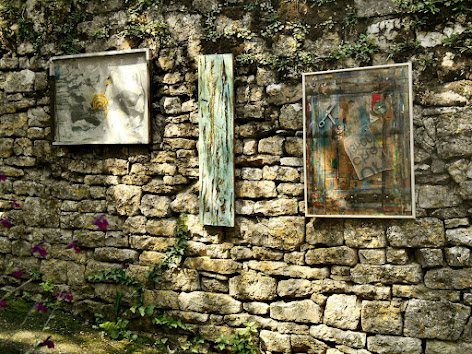in 1976, on a Romanesque church in the west of France.
I thought it was a representation of drunkenness
amongst other depictions of sins particularly condemned
by the moralists of the 11th and 12th centuries.
I was (of course) wrong. It shows a sinful man,
but he is not a drunkard. He is a musician, a category
loathed by the Christian Moralists because, to them,
music meant dancing, and dancing meant sex.
Corbels on the outside of churches often showed
Unchristian Behaviour and Spectacle,
and featured acrobats, contortionists, dancing bears,
exhibitionists, mummers and actors, lascivious animals
(pigs and dogs being the most common).
This corbel*, on the parish church at Givrezac
in western France, shows a Dolio-player,
not a man drinking straight from a barrel.
Because non-religious music led to sexual immorality
he is shown with diabolical (pointy) genitals.
He is also wearing a horned cap, such as an actor
or jongleur might wear,
to emphasise his devilish unacceptabliity.
Hundreds of such corbels can be seen on French and Spanish churches.
The consumption of alcohol was not discouraged
because weak beers and wines were the only liquids
(apart from milk)
that could be drunk safely, especially on the busy Pilgrim (Religious-tourist)
Roads to Rome and Compostela, along which monasteries
(mostly Benedictine) ran canteens and dormitories
and hospices and mortuary (and probably insurance) services.
In the twelfth century over a million Pilgrims (Religious Tourists)
crossed the Pyrenees on their way to Santiago de Compostela.
and so it goes
*a corbel is a bracket support for an architectural weight,
in this case the weight of a barrel-vaulted roof
resting on a beam of stone or wood laid along the wall of the nave of a church.
The word derives from the French for Raven (corbeau, corbie in vernacular English)
– don't ask me why! Perversely, the French for this type of figurative corbel is modillon.
http://www.beyond-the-pale.org.uk/Dolio.htm
















